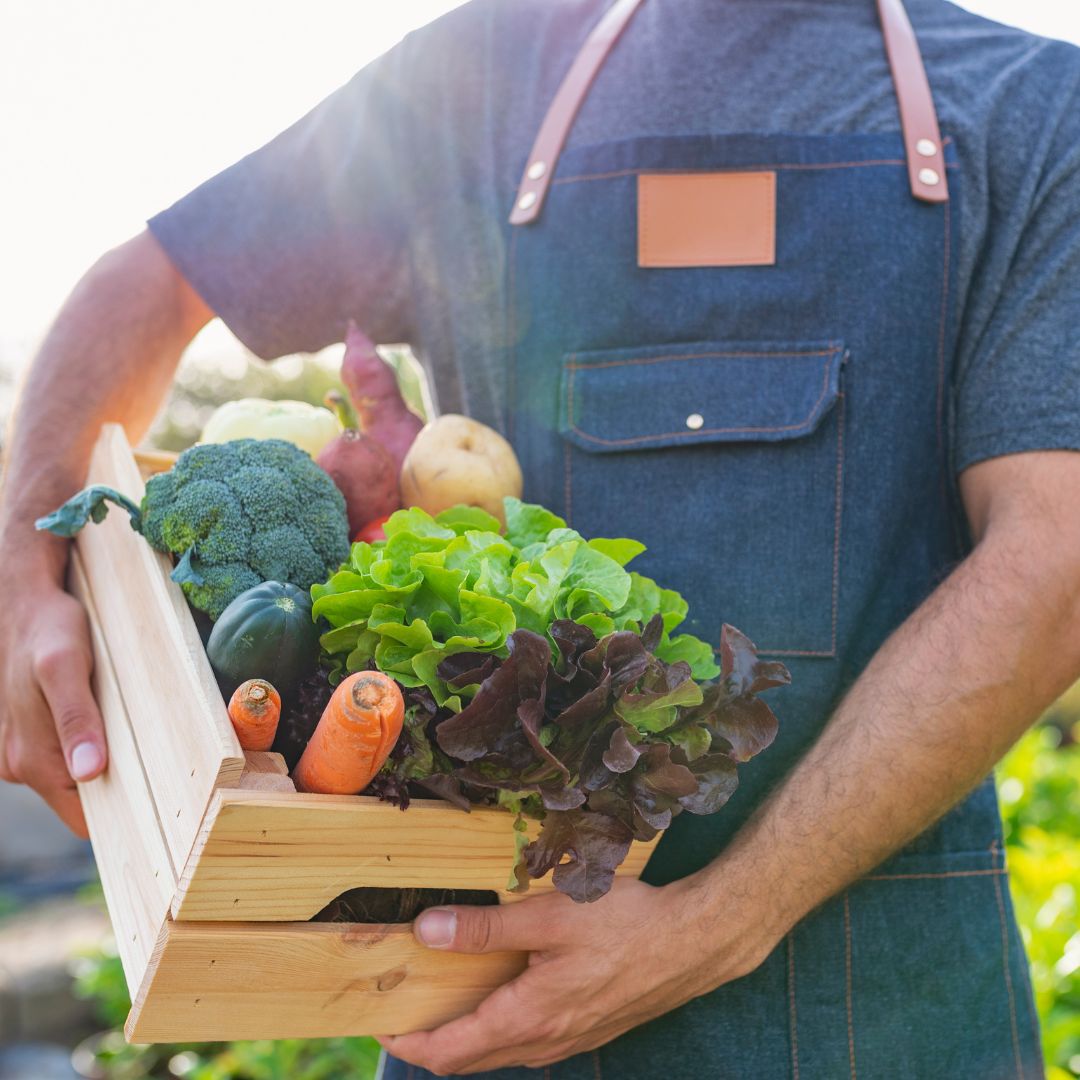
Should you eat organic?
These days, finding organic food is easier than ever. Back in the day, if you wanted to eat organic, you’d have to grow your own or find a health food shop. The range of organic products available today – even in supermarkets - leaves hardly anything to be desired.
You can buy wholemeal flour as well as white flour, light and dark pasta, organic strawberries and organic asparagus, natural juices, organic meat, sausages, fish, poultry, eggs and dairy. Even ready or almost-ready meals such as pizza, tortellini and frozen chips are available organic, as are delicatessen specialities, wines, beer and spirits.
Even those with a sweet tooth can get their money's worth: organic sweet cakes and biscuits sweetened with sugar or honey are readily available in most supermarkets. Note though, organic sugar (and honey) is sugar and impacts your blood sugar level in the exact same way as regular sugar.
Whether purchased from a supermarket, a health food shop or a farm shop, organic food has always been more expensive than conventional food. However, over the last few months we have seen prices skyrocket. Not only is food – any food – now more expensive than it used to be, but we also have much higher energy prices to contend with, which further reduces the money we’ve got left to spend on food. So, is organic food worth the expense?
What are the benefits of organic food?
There are many good reasons to reach for organic products. Health, sustainability, animal welfare, and the wish to support organic farming all come into the decision to buy organic.
Organic food and animal feed is grown without synthetic pesticides and herbicides, resulting in less chemical residue on the finished produce. In an attempt increase yields and resistance to pests and harsh weather conditions, the chemical industry started developing agricultural chemicals just after the WWII.
They were used liberally for decades and did, in fact, do what it said on the tin. It only gradually became apparent that they might also be harmful to both human and animal health and, what’s worse, are persistent, i. e. they are virtually indestructible and will pollute our soils for centuries to come. Needless to say, they are in the food chain by now and are here to stay. Babies are now born with hundreds of chemicals already in their bodies, and persistent pollutants have now even reached polar bears. If they’re affected, what hope to we have?
Gradually, some of those offending chemicals were banned in the US, the EU, and the UK to varying degrees, but not all of them. Moreover, those that are no longer allowed for use in the industrialised countries instead sold to developing countries. Of course, because they are already everywhere and are persistent, those substances are found in organic as well as conventional food. However, organic farming at least puts a stop to their use, reducing future pollution, and, of course, the resulting produce and meat contains fewer harmful chemicals than conventional food. This is one reason why organic food is healthier.
Without pesticides, herbicides, greenhouses and synthetic fertilisers, organic produce must fend for itself, unlike conventional foods, which is mollycoddled from sprouting to harvest. Rather than being grown in huge monocultures, organic fruit and vegetables are planted alongside other plants that help protect them. Plants contain natural substances that fight pests and other threats to the plant’s health and increase its resistance to varying weather conditions. As it happens, these substances are not just good for the plant, but for us to. They are called phytonutrients. All plants contain them, but there are more of them in organic fruit and veg because they need them for their own defence.
Organically grown food is also more likely to be allowed to grow to full ripeness on the tree or in the field, at least if it is destined for local shops rather than being shipped around the world. That way, it has more time to accumulate and develop nutrients – vitamins, minerals and phytonutrients – that contribute to the nutritional value of the end product.
Animals raised to produce organic meat, dairy or eggs, must be fed organic animal feed. Their welfare has a much higher priority than it does in conventional farming, resulting in more space for the animal to move around, more time spent outdoors and straw covered surfaces rather than bare concrete or wire mesh to stand or lie on. Although with reference to beef and dairy, ‘organic’ does not necessarily mean ‘grass-fed’, organic cattle is fed much more grass – both fresh and hay – than conventional cows. Grass is the food cows evolved to eat, resulting in healthier animals and consequently healthier animal products. Unlike the grains or soya conventional cattle is fed on, grass and herbs have a higher omega-3 content, which, of course, affects the fatty acid composition of the resulting meat and dairy products.
As it turns out, food – whether that’s plant of animal food – that is grown and raised the way it should, even tastes better.
More and more people want to act responsibly not only for their own nutrition and for better taste, but also for animal welfare and the environment. They want a sustainable food system, and those who buy organic products support the goal of organic farming to create closed cycles between animals, humans and plants. But this comes at a price that is harder and harder to afford.
Why is organic food more expensive?
Agricultural chemicals were once introduced to increase yields – which they did. Consequently, organic farming does not result in the same amount of food for the same or even increased effort.
Natural pest control can be rather time-consuming. Ideally, you can group plants together in such a way that they protect each other, but sometimes organic farmers have to literally pluck pests off their plants or get down on the ground to pull weeds.
Obviously, allowing indoor and outdoor space for the animals also reduces the number of animals a farm can raise. Organic cheese, unlike mass-produced, cheap cheese, has been given time to ripen and develop flavour. Organic sourdough bread is allowed to ferment and rise naturally, rather than sped up with artificial rising agents.
So, all that effort, space and time put into the production of organic food and the reduced yield that goes with that, is, of course, reflected in the price – but also the flavour and nutritional value of the resulting food products.
If you can’t afford to buy organic only, would it help to pick and choose?
Yes, it absolutely would. Our conventional food is polluted to varying degrees. Some plants are hardy and/or have very effective self-defence, such as onions, carrots, beetroot, parsley, chicory and more. The phytonutrients they produce protect them from pests (and are also very beneficial for us). Consequently, such plants are left to their own devices and allowed to grow without chemical interference. However, many other types of fruit and vegetables are soft and delicate and easily fall prey to pests: potatoes, berries, apples and spinach are among the most sprayed foods and should be purchased organic if at all possible.
In the US, the Environmental Working Group publishes the “Dirty Dozen” (most polluted fruit and veg) and “Clean 15” (least polluted) to help customers prioritise. It must be said that, of course, the United States and Europe have vastly different laws concerning the use of agricultural chemicals. It is a sobering thought that kale – which at least in its natural state is so often hyped as a superfood therefore popular in health-conscious household – is treated with a carcinogenic chemical called DCPA (or dacthal in the US). The European Union banned DCPA in 2009. However, delicate fruit and veg remain delicate and are more likely to be treated with pesticides and/or herbicides than tougher plants, and in that respect the EWG guides are still useful.
(Links: https://www.ewg.org/foodnews/dirty-dozen.phphttps://www.ewg.org/foodnews/clean-fifteen.php )
Another aspect to consider is surface area. The smaller the plant product the larger the surface area. Grains and seeds provide a larger area for pests, bacteria and moulds to settle on, making them more vulnerable. Therefore, seeds and grains receive more treatment, just like soft fruit does. So, if you need to prioritise your spending on organic foods, consider buying organic rice, pasta and flour.
What if there is no way that you can afford anything organic?
The unhealthiest foods on the planet right now are ultra-processed industrial products. They are high in sugar, unhealthy fats and salt while being completely devoid of nutrients. Only the most cheaply produced agricultural products go into them, and animal welfare or the protection of the environment are not on the agenda. If you shun junk foods for the benefit of home-cooked meals and snacks from conventionally produced ingredients, you have already made the biggest step towards good health.
Also, not all food that doesn’t carry the label “organic” is doused in chemicals. Many farmers grow their fruit and veg and raise their animals in a sustainable way. To all intents and purposed, their products are organic, but they’re not allowed to call them that for various reasons. It could be that pesticides and herbicides are used on a neighbouring farm or have been used on their property in the past, preventing them from ever obtaining the classification as organic for their own crops. It could be that the process of getting accredited is just too lengthy and expensive, so they don’t bother. As a result, they can’t sell their products for quite the same price. It is worth checking out the farm shops and farmers markets in your area. Ask questions, read websites, find out more about the food grown where you live. It might be just as good as organic.
Buying local and seasonal food also means that you will get fruit and vegetables that have been allowed to grow to full ripeness and are still fresh by the time they reach your table. A conventional carrot pulled from the ground yesterday may be a lot more nutritious (and cheaper!) than an organic avocado picked in Brazil six weeks ago. “Organic” does not mean healthier as a general rule.
Some of the pesticide-laden foods you may not need at all. Grains are staples in the Western diet. Bread, pasta and rice grace our tables several times a day, so buying all of that in organic quality can quickly add up to a very high food bill. And yet, we don’t really need these foods at all. Such starchy carbohydrate foods mess with our blood sugar levels and are known to contribute to overweight and obesity. They are at the heart of type II diabetes and many scientists even consider them addictive. At the same time, starchy foods do not contain any nutrients we couldn’t get elsewhere. A diet of vegetables, low-sugar fruit, nuts, seeds, meat, fish, dairy and eggs provides everything we need. So, if you reduce your intake of bread, rice, pasta and baked goods, buying only organic – if any – your health would even benefit.
No matter how much organic food you can afford and for all the good this might do, if you do not have a lot of money there is still a lot you can do – for your health, the environment, and the animals – by choosing wisely and taking and interest in how, where and by whom your food is produced.
The best thing you can do is to cook from scratch. After that, prioritise and select your (organic) foods wisely.
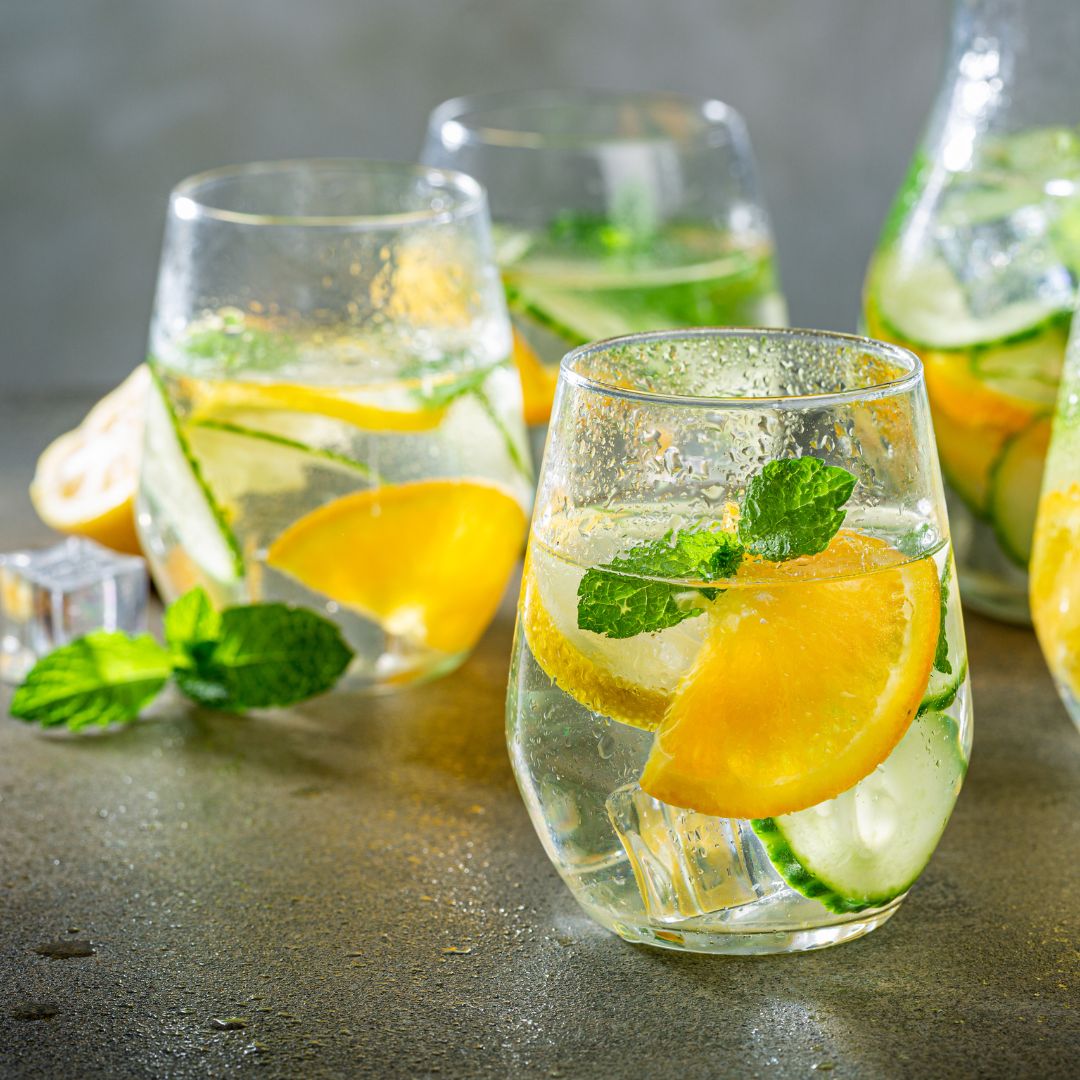
Summer Drinks
Summer parties are often filled with sweet, alcoholic drinks that can lead to rollercoaster blood sugar levels.
It’s not always easy to know what to drink instead without feeling deprived. But I’ve got a few delicious and refreshing alternatives for you to try.
Strawberry lemonade
Serves 8
2 litres water
8 lemons, squeezed (around 280 ml)
1/2 -3/4 tsp liquid stevia (try NuNaturals)
250g strawberries, sliced
In a large jug combine water, lemon juice and stevia. Simply stir in sliced strawberries and serve over ice.
Cucumber, mint and lemon fizz
Serves 6
1.5ltr sparkling water
half a cucumber, sliced
10 mint leaves
1 lemon, sliced
Put all the ingredients in a large jug, chill and serve.
Sparkling cherries
Serves 2
4tbsp Cherry Active
500ml sparkling water
Add sparkling water to the Cherry Active and serve with ice.
Sparkling lime water
Exactly as it sounds …
Sparkling water with a good squeeze of fresh lime juice over ice. Simple and refreshing – and you can guarantee a pub with have the ingredients (but likely you’ll need to remind them about the fresh lime and not cordial!).
Garden Sour
Seedlip Garden (a distilled, non-alcoholic drink*), 50ml
Cloudy apple juice, 35ml
Lemon Juice, 15ml
Cider vinegar, 5ml
Sprig of rosemary & thyme
Seedlip is premium distilled non-alcoholic drink. The price may make you wince (it’s no cheaper than buying alcoholic spirits) but it’s hot news this year and making an appearance in all the top bars…
Find it at www.seedlipdrinks.com
Sparkling kombucha
Kombucha is a healthy alternative to sparkling soft drinks known for being full of naturally occurring vitamins, acids, and beneficial bacteria. Making it is a labour of love. Learn how to make it here: https://happykombucha.co.uk/pages/how-to-make-kombucha.
Alternatively, you can buy it ready-made, especially if you want to try before you invest your own time in making it? Don’t blame you. I like Equinox Kombucha (www.equinoxkombucha.com).
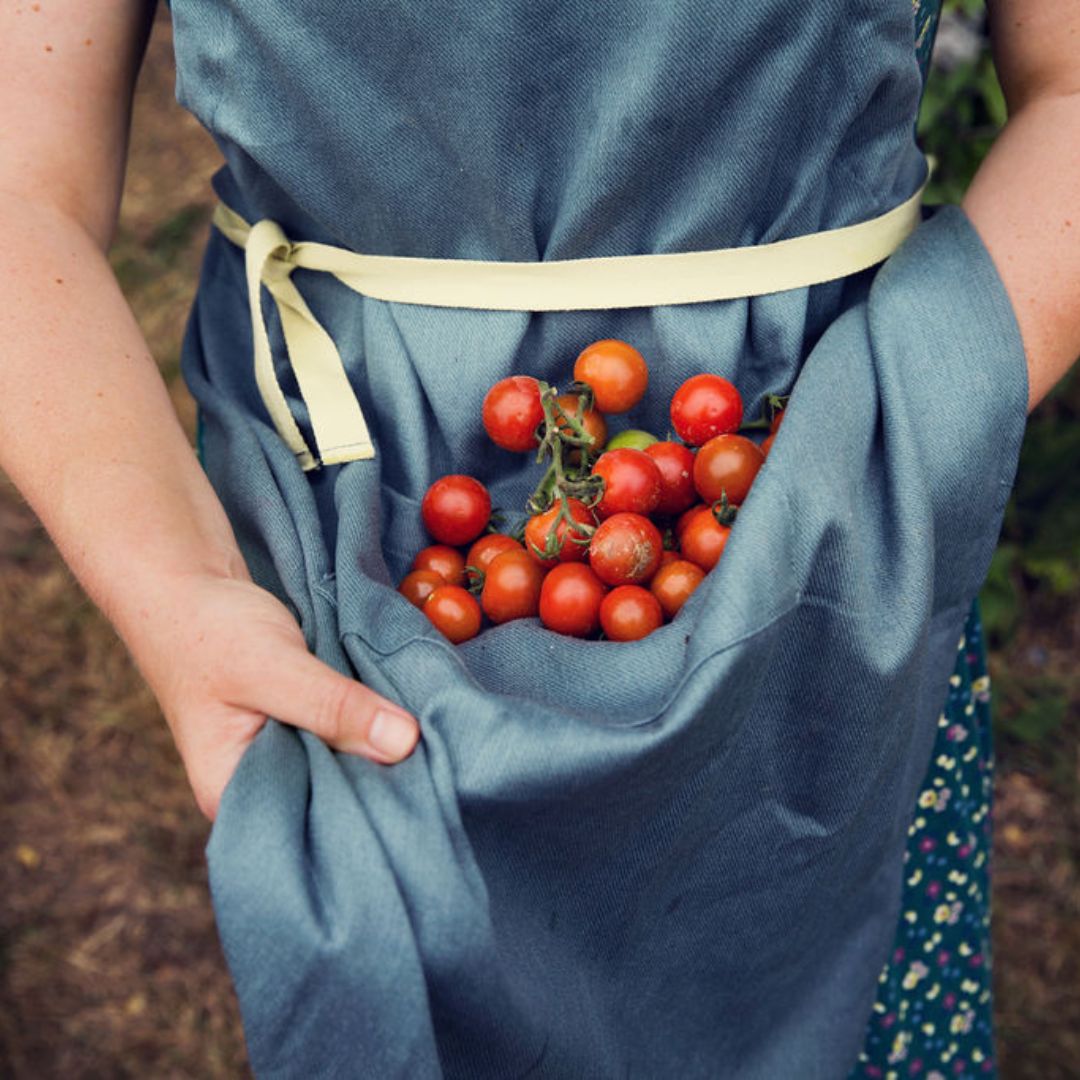
Why We Should All Eat the Seasons
A restaurant menu focused on seasonal produce is often a go-to sensation, but do you know why it’s important to eat seasonally?
Quite simply, when you eat locally and seasonally you know you are eating the freshest, most abundantly available produce. It is better for everyone – you get the tastiest veg, the local farmer benefits, and food miles (the distance our food has to travel from the farm to your fork) decreases so you get to save the environment, too.
Another unexpected benefit is to reconnect to nature’s seasonal cycle. If you have children, this is especially important as it teaches that food does grow at specific times, a hard concept to grasp when imports from all around the globe ensure that supermarket shelves look the same practically every week of the year.
If you're wondering when you should start, the answer is: now. A survey in BBC Good Food magazine showed we’re not as good as we think at figuring out what is in season when. Of the 2000 people it asked, 86% claimed it was important to shop seasonally, 78% said they were doing it – and yet only 5% could say when blackberries were at their best.
I want to help make this the year that you can embrace this concept. Firstly, you can check my newsletter or Instagram for regular reminders of what’s in season each month and a little inspiration for what to do with it (Link to sign up to the newsletter – www.alexallannutrition.co.uk/sign-up).
Where to buy seasonally
Farmers’ markets are a great place to find local seasonal veg. Make it your mission this month to find out what’s on near you. Ask friends and family and, if you’re feeling bold, ask the question on your Facebook page to get the quickest response.
Failing that, try these two resources to find a place near you:
http://www.findlocalproduce.co.uk/
https://artisanfoodtrail.co.uk/events/
https://saturdayandsunday.co.uk/weekend-farmers-market-directory/
Having someone else do the hard work and just bring you the goodies is also a good thing. If you’ve never considered getting an organic veg box, it can be an amazing experience. It’ll teach you super fast what is in season when, you’ll get some of the best produce available in your area and delivered to your door, and it will wake you up to the magic of cooking.
I wonder whether this resonates with you. I actually LOVE cooking but with a family and running a busy clinic, even for me it often turns into a real chore; a juggling act between what everyone wants to eat (usually the same things week in, week out) and what I have actually got in the fridge or cupboards. Inviting a veg box into your life forces you to try something new, and this can be very invigorating. Of course, you can pick and choose the types of ingredients you want and avoid having things added that your family hates, but I urge you to have a go and see what happens.
The following offer a huge variety of veg-only or fruit and veg boxes, some even with a ‘pick your own’ element where you can pick and choose exactly how much of what you have
https://www.riverford.co.uk/shop/veg-fruit-and-meat-boxes
https://www.eversfieldorganic.co.uk
Do check my blog for recipe inspiration, but let’s start off with something delicious that you might not have tried that’s in season this month – courgettes!
Courgettes are a great source of potassium, a mineral which helps to keep our muscles working properly so we can move around. Courgettes also contain a good amount of both vitamin C and folic acid. Just half a large courgette counts as one of your 7-a-day (one portion of veg or fruit is 80g raw weight).
Serves 4-6
3 medium courgettes, sliced
300g trimmed green beans
2 x 200g blocks of feta, each cut in half
4 tbsp olive oil
4 garlic cloves, crushed
Handful thyme leaves
Zest of 3 oranges
50g fresh gluten-free breadcrumbs
75g hazelnuts, roughly chopped
extra virgin olive oil, to serve

10 tips to stay healthy all summer long
As the temperatures rise and the days get longer, it's the perfect time to revitalise your health and wellbeing. In this blog, I’ll explore simple yet effective strategies to keep you feeling your best during the sunny season. From hydration tips to sleep solutions, I've got you covered, so let's dive in and make this summer your healthiest yet.
1. Drink more water
Stay refreshed and revitalised by increasing your water intake this summer. Not only does water keep you hydrated in the heat, but it also supports digestion, boosts energy levels, and promotes radiant skin. If you’re hoping for a little last minute weight loss before your summer holiday, it’s also worth knowing that staying hydrated will stop you confusing hunger with thirst.
Make it a habit to carry a reusable water bottle with you wherever you go and aim to sip consistently throughout the day. Your body will thank you for it. How much you need will depend on the heat as well as your activity level. The absolute minimum is about 2L.
Simple strategies for staying hydrated
2. Cut back on alcohol
While it's tempting to indulge in a cool beer or a chilled glass of white wine during summer gatherings, alcohol consumption takes its toll on your health – even in small amounts. The NHS recommends adults over 21 drink fewer than 14 units a week (low risk drinking). Holiday drinking can really mount up – especially if you’re pouring yourself or you’re at an all-inclusive resort. It’s worth considering that binge drinking (as described by the NHS) is 6##plus## units (women) or 8##plus## units (men) in a single session. This is less than two large (250ml) glasses of wine for women or 2.5 glasses for men.
Challenge yourself to limit alcohol intake and explore refreshing alternatives like mocktails or infused water. Your liver will appreciate the break, you’ll have better control over your weight, feel calmer and less anxious, suffer less severe hormonal symptoms, and you'll sleep much better, so you wake up feeling more energised and focused the next day.
3. Get your steps in
One of the things many of us are guilty of is less activity in poor weather. With the fine weather firmly with us, make the most of the longer daylight hours by prioritising physical activity. That shouldn't only mean structured exercise. Aim for at least 10,000 steps a day on top of your regular exercise regime to boost your cardiovascular health, strengthen muscles, and enhance mood. Whether it's a morning stroll, an evening jog, or a lunchtime walk in the park, find opportunities to move your body and soak up the sunshine.
If you’re away on holiday and unable to commit to your regular workouts, there are plenty of ways to keep moving, including beach treks and city walking tours. You might be surprised how many steps you can get in when you’re not tied to your desk all day.
4. Get the sleep you need
Sleep is essential for overall health and wellbeing, but it can be challenging to get adequate rest when the days are long, and the nights are light. To counter this, you’ll need to put a little extra work into your night-time routine. You may find you sleep a lot better in a darkened room. This can feel challenging enough at any time of year if you live in an urban area, but summer adds an extra level. No one ever regretted investing in blackout blinds and/or a silk sleep mask. Take notes from the Scandinavian countries – where the sun rarely goes down for more than a few hours in summer – and throw all you can to tip the scales in your favour (note: these tips help create a more restful space for sleep at any time of year):
Limit screen time before bed, use a calming pillow mist like lavender to soothe the sense, practice relaxation techniques such as deep breathing or gentle yoga stretches. They also love their fish, especially salmon and tuna, which are high in vitamin B6, which helps your body produce more of the ‘sleep hormone’ melatonin.
5. Nourish your body with seasonal foods
We are officially in salad season but there’s a lot more to healthy summer eating than a few lettuce leaves. Take advantage of the abundance of fresh fruits and vegetables available during the summer months. Incorporate colourful produce like berries, tomatoes, cucumbers, and leafy greens into your meals to provide your body with essential vitamins, minerals, and antioxidants.
Variety is not only the spice of life; diet diversity is the gold when it comes to health and wellbeing. If you can reach 50 different plant foods in a week, consider yourself a master. Most people get stuck in a rut of eating a small number of different fruits and veggies and rotating them. Trying to hit 50 is a fun challenge to take on when salads are aplenty, as they make it significantly easier to ramp up the numbers. Different salad leaves count as different foods, different types of apple count as different foods for the purposes of this challenge, as do all herbs and spices. If you made a stir fry with herbs and spices, and a bunch of different veggies, you could hit 10 different foods without too much trouble. Your body loves this variety! Have fun and see how many foods you can get. Simple tips: rotate bags of salad (finish the iceberg, buy romaine, then lamb’s lettuce, then rocket, for example) and, if you grow your own herbs, now’s the chance to add them to all your meals!
6. Vitamin D v skin protection
The lack of sunshine in winter months can play havoc with your health in general and also your mood because your body makes an important hormone (vitamin D) when the sun’s ultraviolet B (UVB) rays are absorbed through your skin. This means summer (and sunny holidays) is a great time to top up your vitamin D levels.
However, there is a bit of a balance needed between exposing your skin to the sunlight without wearing sunscreen and not spending too long in the midday sun and damaging your skin – or worse. The research on this is a little confusing and contradictory for many people: while sunscreen does not mean you will have vitamin D insufficiency or prevent your body producing any vitamin D at all when you are in the sun, it will reduce the amount you make. It is worth noting that many of the studies that say vitamin D status is unaffected by sunscreen were based on studies that used sunscreens with an SPF of 15 – and some were funded by sun cream manufacturers.
So, you must make your own judgement. A little exposure earlier in the day may be beneficial if you have lighter skin (you can get the vitamin D you need in 15 minutes) but going out for the afternoon without sun protection or sunbathing is not advised since we know that unprotected sun exposure/ getting sunburnt leads to sun damage, which may result in skin cancer.
Those with darker skin can need twice as long – or more – in the sun to get enough vitamin D, putting them at greater risk of sun damage.
Enjoy the sunshine responsibly by practising sun safety measures to protect your skin from harmful UV rays. Wear sunscreen with a high SPF, seek shade during peak sun hours, and wear protective clothing such as hats and sunglasses. Consider supplementing with vitamin D if you have darker skin and/or do not regularly expose your skin to the sun.
7. Prioritise mental health
Summer is a time for relaxation, so don't forget to prioritise your mental health, too, if you want to feel rejuvenated. Take breaks from your busy schedule to unwind and recharge, whether it's through meditation, mindfulness, or spending time in nature.
Now is the perfect time to connect with loved ones, practise gratitude, and find joy in the simple pleasures of summer.
8. Keep cool and beat the heat
When the summer sun is blazing, it's crucial to stay cool and comfortable to maintain your health and vitality. As much as we spend the year in the northern hemisphere waiting for summer to arrive, high temperatures can make you feel depleted. Beat the heat by seeking out shady spots, wearing light and breathable clothing, and using fans or air conditioning to stay cool indoors. Additionally, indulge in hydrating treats like frozen fruit popsicles or refreshing smoothies made with water-rich fruits like strawberries and oranges. By prioritising staying cool and comfortable, you'll not only feel better physically but also be able to enjoy all that summer has to offer without the risk of overheating.
A cup of tea might paradoxically bring relief from the heat. In Asian cultures, tea has long been consumed to beat the heat. The natural compounds in tea – like L-theanine – were believed to have a cooling effect on the body.
9. Embrace outdoor activities
Make the most of the sunny weather by engaging in outdoor activities that get your body moving and your spirits soaring. Whether it's swimming, hiking, cycling, or playing a game of beach volleyball, find activities that bring you joy and allow you to connect with nature. Remember to stay hydrated and protect your skin from the sun while enjoying your outdoor adventures.
10. Practise gratitude and mindfulness
As summer unfolds, take a moment to pause and appreciate the beauty and abundance that surrounds you. Practise gratitude for the simple pleasures of life, whether it's a breath-taking sunset, a refreshing breeze, or the laughter of loved ones.
Some people like to keep a gratitude journal. Set aside a few minutes each day to write down three things you're grateful for. This could be anything from the people in your life to the simple pleasures of daily life. By focusing on the good things in your life, you can start to build a more positive outlook.
It’s also fulfilling to express gratitude to others by taking time to thank the people in your life who have made a positive impact on you.
Gratitude and mindfulness go hand in hand. Take a few minutes each day to simply focus on the present moment and appreciate the world around you. This could be as simple as taking a walk outside and noticing the beauty of nature, or savouring a cup of tea and enjoying the taste and aroma.
By incorporating these ten strategies into your summer routine, you'll not only feel healthier and happier but also set yourself up for long-term wellbeing. Here's to a summer filled with health, vitality, and endless possibilities!
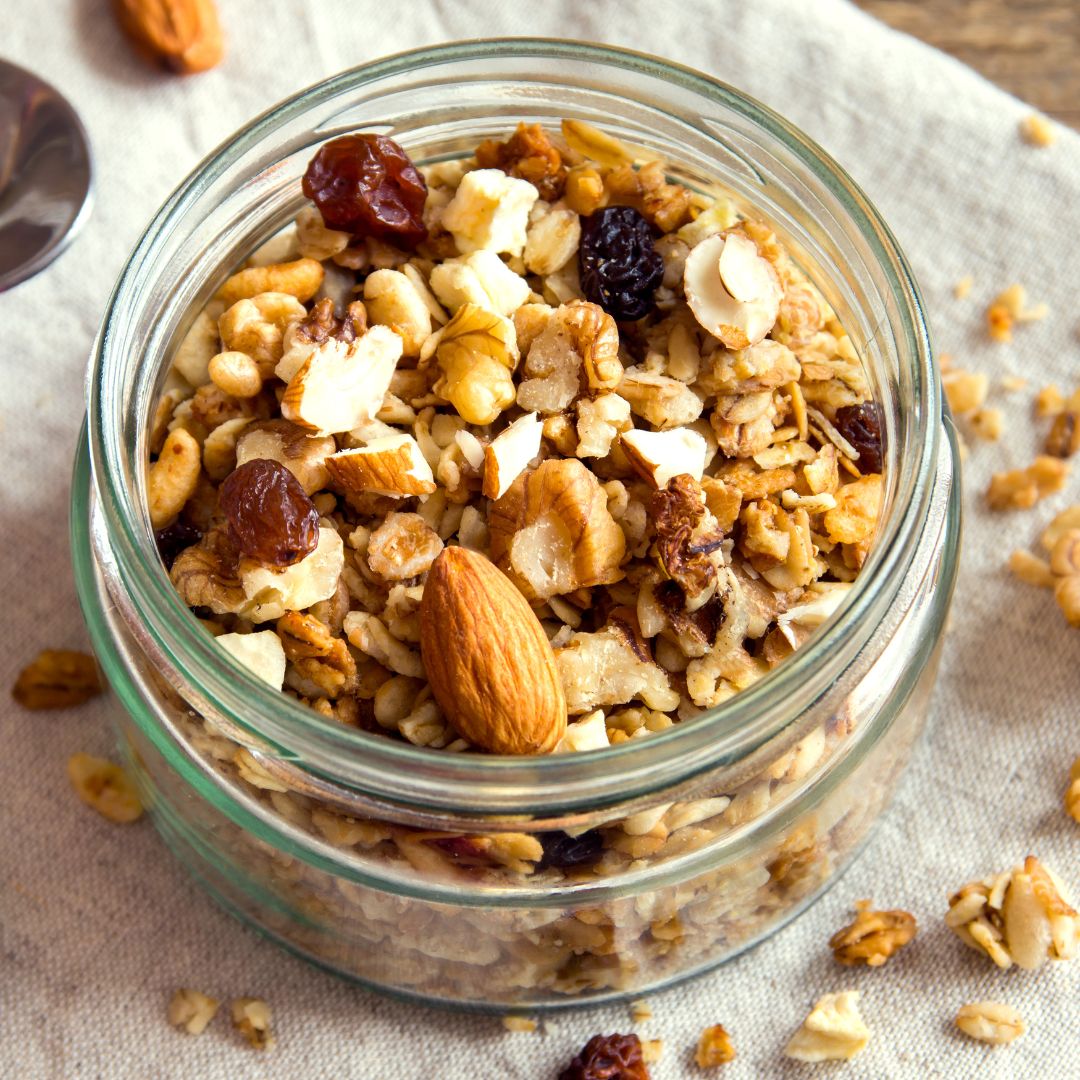
Paleo Granola
This is a healthy, protein-rich breakfast, perfect for pairing with summer fruits and whole Greek or coconut yoghurt. Perfect for the warmer weather!
Makes approximately 12 servings
Ingredients:
140g almonds
125g cashews
35g pumpkin seeds
35g sunflower seeds
35g unsweetened coconut flakes
40g coconut oil
1 tsp vanilla extract
1 tsp cinnamon
1 tsp sea salt
Method:
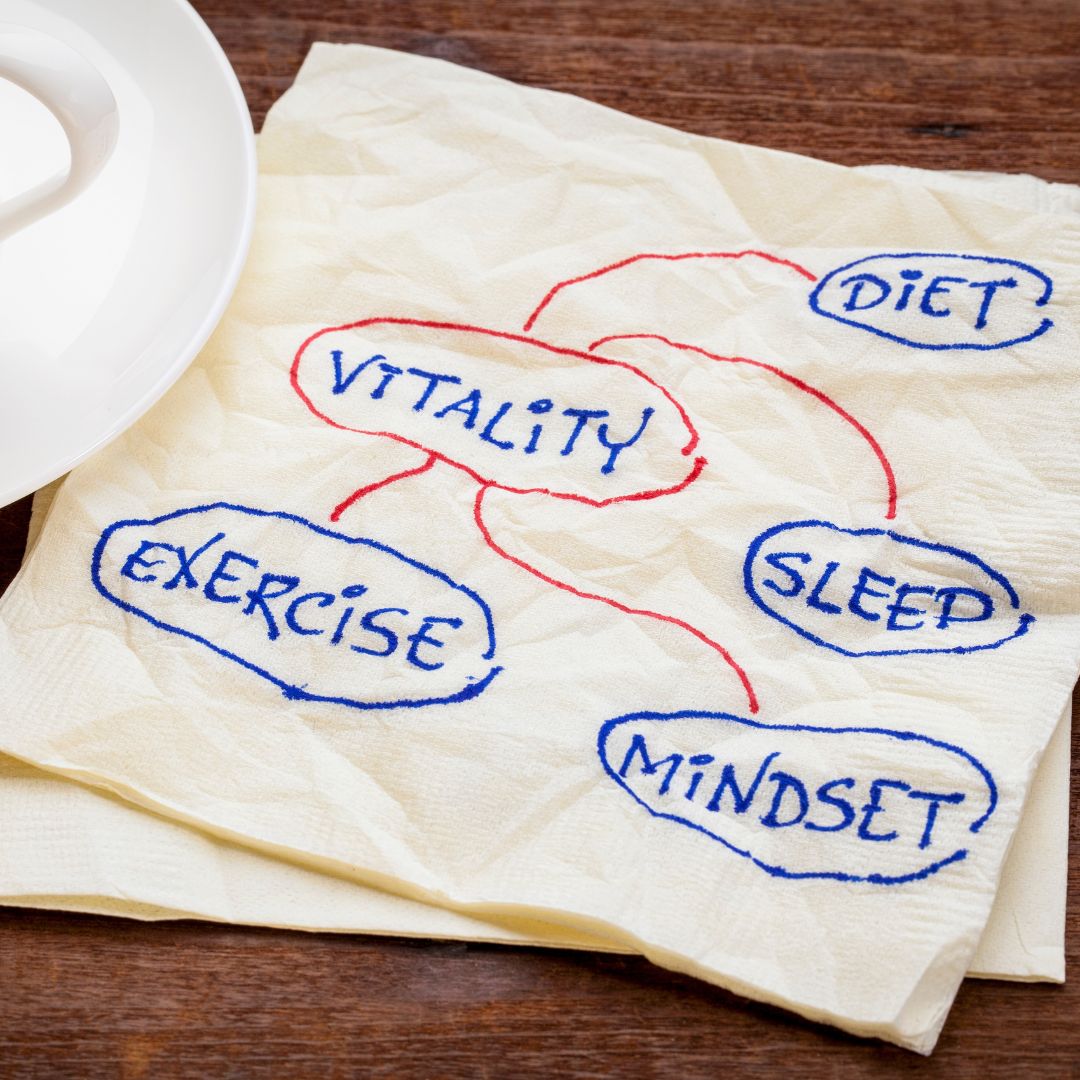
Lifestyle Changes to Improve Your Mood
Exercise – Exercise plays a big part in beating the blues
A number of studies, in which people exercised for 30 to 60 minutes, 3 to 5 times a week, found a drop of around 5 points in their Hamilton Rating Depression Scale – more than double what you’d expect from anti-depressants alone.
If you are feeling down and de-motivated, it’s not easy to get started on exercise: but the benefits are worth it.
Exercise increases blood flow to the brain and raises levels of the brain chemicals serotonin and dopamine. Higher serotonin levels make us feel good. Dopamine helps create a sense of motivation. Natural light also stimulates serotonin.
Exercise helps you to sleep, because it can “burn off” excess adrenalin. It helps to balance blood sugar and lose weight and that, in turn, improves your mood and motivation. When you get started, aim for 20 minutes of exercise five days a week, preferably outdoors. If you are significantly overweight, this could be brisk walking – 30 minutes a day would be better.
Find something you like doing, preferably in a pleasant area, and with other people. It’s great to have an exercise buddy. Exercise then becomes another means of focusing attention away from yourself and your preoccupations, and of spending enjoyable time with others. An exercise buddy also adds accountability. You are more likely to show up.
Following the low-GL mood boosting diet, and maybe taking the right supplements, will improve energy levels enough to give it a go.
Sleep – Mood and Sleep have a lot in common
Lack of sleep has a big effect on how you feel, and finding out how to sleep through the night and wake up refreshed could be the missing piece in getting you to feel a whole lot better.
The amino acid tryptophan is not only the raw material for serotonin but also for melatonin, a brain chemical that helps you sleep by controlling the sleep/wake cycle. It’s the brain’s neurotransmitter, which keeps you in sync with the earth’s day/night cycle. Jet lag, for example, happens when the brain’s chemistry takes time to catch up with a sudden time zone shift.
As you start to wind down in the evening, serotonin levels rise, and cortisol levels fall. As it gets darker melatonin kicks in.
But what can you do to improve your quantity and quality of sleep?
Provide more of the building blocks that make serotonin – tryptophan, an amino acid present in most protein-rich foods like chicken, cheese, tuna, tofu, eggs, nuts, seeds, and milk.
The conversion from tryptophan to serotonin requires folic acid, B6, vitamin C and zinc. These can be found in beef, broccoli, cashews, chicken, chickpeas, cauliflower, peppers, kale, kiwi, lamb, oranges,
parsley, pumpkin seeds, pineapple, salmon, spinach, turkey, and tuna.
SLEEP ACTION PLAN
![]()
Please get in touch and find out more - I offer a free 30-minute exploratory call.